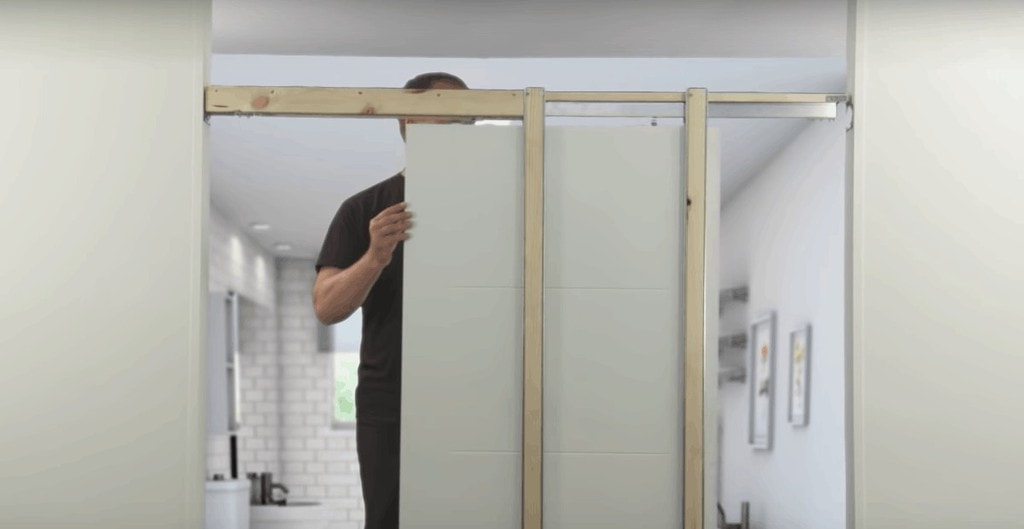An ill-functioning pocket door can cause a headache every time you go to open or close it.
Fortunately, there aren’t a million things that can possibly go wrong in this system; if something’s not working properly, either the rollers are seized up, they’ve fallen off the track, or some of the hardware has become broken or damaged.
Like anything, over time the hardware and componentry of these systems can wear or become damaged, causing the door to stick, not slide correctly in its tracks, and/or not close flush with the wall.
This article will guide you through the process of figuring out the problem that’s keeping your pocket door from functioning properly, making any necessary hardware adjustments, and, if necessary, provide a step-by-step for how to replace the entire rolling track and hardware within the system.
Easy Fixes First
Often times, repairing something is as simple as taking the time to take a good look at it, and getting an understanding of how it works.
Most all pocket doors operate on a track system which is fastened inside the frame of the door. Brackets are fastened to the top of the door, which secure the rollers that fit inside the track and allow the door to slide smoothly in and out of the pocket. Often, a pocket door that won’t slide correctly can be traced to rollers that have become seized up or damaged. If this is the case, the rollers can be easily replaced, or possibly even unseized by adding a few drops of household lubricant.
It’s also common for the rollers to simply come out of the track, and fixing the door is as simple as putting them back in. However, if one or both of the rollers have fallen out of the track, the track itself becomes damaged and will need to be replaced.
Diagnosing Pocket Door Problems
To diagnose the damage and identify the problem that’s keeping your door from operating smoothly, the first thing you’ll need to do is remove the door itself.
To do this, you’ll need to remove some of the casing/molding around the door, and possibly the door frame itself.
Use a utility knife with a good sharp edge on it to break the caulk seal around the casing. Once all of the caulking/sealant has been removed, you can then use small putty knives and pry bars to gently remove the door stop, and any necessary casing.
To remove the door, simply swing it out from the bottom and lift it out of the tracks. A lot of times if the rollers have come out of the track and the door is inside the pocket, it can be a bear trying to pull the door out. Be careful not to damage any of the framing if this is the case.
Once you have the door and some of the casing removed, you can inspect the system for damage. Check the rollers and mounting brackets on the top of the door for anything that is bent or broken. Try and roll the rollers with your fingers - if they’re seized up, see if a little lubrication frees them.
If the rollers and brackets appear to be in good condition, it’s possible that the track has become bent or damaged. If this is the case, it will need to be removed and replaced with a new one. This involves cutting a hole in the wall so that you can access the track on the inside of the pocket.
Use a good spotlight to have a look at the inside of the pocket door, and see how the frame is constructed. If you’re going to cut a hole in the wall, you don’t want cut through any of the door frame. Use a stud finder to locate the studs in the door frame, and outline an area or areas inside the studs that you can cut out. Make sure you allow yourself enough room to access the entire track for removal and installation of the new one.
Once the track is removed, take good measurements to ensure that the new track you get will fit properly. You have to consider length, as well as the depth and height of the track as well - if you get one that’s taller than the old one, there will not be enough clearance for the door to hang freely.
Installing the new track should be simple, as it’s typically just a matter of screwing it in place inside the door frame. Use a level to ensure that the door frame, and subsequently the track, will be perfectly level once installed. If anything is out of place, attach shims to the door frame until you get a level reading.
Making Adjustments/Finishing the Repair
Sometimes, fixing a pocket door problem can be as simple as making a few adjustments with a wrench.
The rollers that are fastened to the brackets on the top of the door are secured in place with a nut. You can tighten/loosen this nut to adjust the height of the door.
If you’ve got a situation where the bottom of the door is not flush with the floor, for instance, or it doesn’t close flush with the wall, it’s likely that the problem can be solved by adjusting these nuts appropriately. If a general adjustable wrench won’t fit, you may need to use a thin spanner like the one in the link above.
If you had to cut an access hole in the drywall to remove the old track, try and re-use the same piece of wall that you cut out. Attach thin strips of wood to the cutout to use as backers, so you can simply pop the cut-out piece back in, and screw it in place into the backers. Then, finish the job by using spackle or joint compound to fill in and seal the seam.
Here’s a great informative video from Ron Hazelton on how to replace the entire hardware system of a pocket door.
Good luck with your fix!


